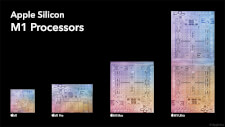M1
The M1 is the first Apple silicon chip. Apple launched the M1 in November 2020 with the Mac mini and MacBook Air.
Unlike previous Mac chips, the M1 is designed and manufactured by Apple. It is ARM-based, meaning it uses a design similar to the "A-series" chips found in iPhones and iPads, rather than the Intel "x86" architecture. Additionally, the M1 is a System on a Chip (SoC), which contains several types of processors. Besides the CPU, the M1 includes a GPU, neural engine, media engine, and "high-efficiency" processing cores that help reduce power consumption.
Not only does the M1 contain multiple types of processors, but most of them are multi-core. Below are the M1 processor specs:
- CPU: 8-core (4 high-performance cores running at a 3.2 GHz clock speed + 4 high-efficiency cores)
- GPU: 8-core (7-core on the low-end model)
- Neural Engine: 6-core (for AI and ML computations)
- Transistors: 16 billion (5 nm)
- RAM: 8 or 16 GB of unified (integrated) memory
- L2 Cache : 12 MB per performance core; 4 MB per efficiency core
NOTE: Apple released two high-performance variants of the M1 — the M1 Pro and M1 Max — with new MacBook Pros in October 2021.
 Test Your Knowledge
Test Your Knowledge